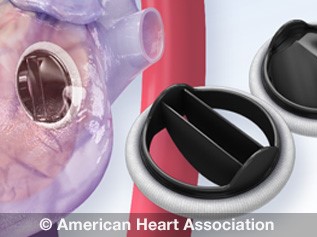what is the alternative to a biventricular pacemaker for someone with cardiomyopathy and chf

Implantable cardioverter defibrillator (ICD)
Some people who have astringent centre failure or serious arrhythmias (irregular heartbeats) may need implantable defibrillators, or ICDs. These devices are surgically placed and deliver pacing – or an electric counter-daze – to the heart when a life-threatening abnormal rhythm is detected. ICDs have saved millions of lives, but are merely appropriate in certain circumstances. The decision to use an ICD is a shared one by the physician and patient.
Larn more near implantable devices.
Cardiac Resynchronization Therapy (CRT)
Some people with eye failure develop abnormal conduction of the heart's electrical system that changes how efficiently the heart beats.
In such cases, cardiac resynchronization therapy (CRT), also known as biventricular pacing, may exist needed. In this procedure, a special pacemaker makes the ventricles contract more normally and in synchrony.
This therapy tin can ameliorate centre role, reduce hospitalization risk and increment survival.
Learn more about cardiac resynchronization therapy.
Left ventricular assist device (LVAD)
- What is a left ventricular assist device? The left ventricle is the big, muscular chamber of the heart that pumps blood out to the trunk. A left ventricular assist device (LVAD) is a battery-operated, mechanical pump-like device that'south surgically implanted. Information technology helps maintain the pumping power of a heart that tin't effectively work on its own. These devices are available in most heart transplant centers.
- When is an LVAD used? This device, sometimes called a "bridge to transplant," is now used in longer-term therapy. People often must await a long time earlier a suitable heart becomes available. During this expect, the patient's already weakened centre may deteriorate further, losing the ability to pump blood throughout the body. An LVAD tin can help a weak heart and "buy time" for the patient, or eliminate the need for a eye transplant altogether. Well-nigh recently, LVADs are being used longer term as "destination therapy" in end-phase heart failure patients when heart transplantation isn't an option.
- How does an LVAD piece of work? A mutual type of LVAD has a tube that pulls blood from the left ventricle into a pump. The pump then sends blood into the aorta (the large blood vessel leaving the left ventricle). This effectively helps the weakened ventricle. The pump is placed in the upper office of the belly. Some other tube attached to the pump is brought out of the abdominal wall to the outside of the body and attached to the pump'southward battery and control system. LVADs are now portable and are oft used for weeks to months. Patients with LVADs can be discharged from the hospital and tin can maintain an acceptable quality of life while waiting for a donor eye to become available.
Surgical procedures for heart failure
Surgery isn't frequently used to treat heart failure. But it'southward recommended when the doctor identifies a correctable trouble that'due south causing centre failure – such as a defect similar a center valve or a blocked coronary artery.
Eye transplantation
Some people take astringent, progressive heart failure that can't be helped by medications or dietary and lifestyle changes. In such cases, a heart transplant may exist the only effective treatment option.
Surgeons supercede the damaged heart with a healthy 1 from a donor who has been declared brain expressionless. It can take several months to find a donor heart that closely matches the tissues of the person receiving the transplant. But this matching process increases the likelihood that the recipient'southward torso volition accept the heart.
During a transplant process, the surgeon connects the patient to a heart-lung auto, which takes over the functions of the middle and lungs. The surgeon so removes the diseased heart and replaces it with the donor middle. Finally, the major blood vessels are reconnected, and the new heart is ready to work.
The outlook for people with eye transplants is skilful during the first few years after the transplant. In fact, about xc percent of patients live for more than a twelvemonth after their operations. However, the number of patients who receive heart transplants is even so relatively depression – effectually 2,500 each year.
Read more than almost middle transplants.
Percutaneous coronary intervention (PCI, also referred to as angioplasty)
Center failure tin develop when blockages in the coronary arteries restrict the blood supply to the heart muscle. Removing these blockages tin improve overall center function, which may amend or resolve center failure symptoms. PCI, often called angioplasty, is one type of procedure to reopen blocked blood vessels.
View an illustration of coronary arteries.
The process is usually performed in the cardiac catheterization lab. A small tube (catheter) with a tiny deflated balloon on the end is inserted through an incision in the groin (or other area where the artery tin be accessed) and pushed through to the diseased avenue. And so the balloon is inflated to button open the artery. The balloon is removed one time the avenue has been fully opened.
A stent may be placed during the procedure to keep the blood vessel open up.
Although there's a slight risk of damage to the artery during PCI, this procedure usually improves the patient'southward status.
Lookout man an animation of PCI.
Coronary artery featherbed
Coronary artery bypass surgery reroutes the blood supply effectually a blocked section of the artery.
During this procedure, surgeons remove healthy blood vessels from some other part of the torso, such as a leg or the chest wall. They and so surgically attach the vessels to the diseased artery so that the blood can menses around the blocked section.
Subsequently a bypass operation, it's especially important for you to reduce the amount of fat and cholesterol you consume, because these substances crusade the arteries to clog. Doctors also recommend increasing concrete activity to strengthen the center muscles.
View an illustration of coronary artery featherbed.
Valve replacement
 Eye failure is sometimes acquired by a lacking or diseased heart valve.
Eye failure is sometimes acquired by a lacking or diseased heart valve.
Centre valves regulate the flow of claret inside the heart. When the valves don't work properly, this puts extra strain on the middle and can pb to heart failure.
For some valve issues, medical management is the first pace in handling. Correcting the problem surgically often improves or resolves the condition too.
A variety of different replacement valves tin can be used, including a mechanical valve made from metal and plastic, or i made from human or animate being tissue. During the surgery, the patient is continued to a eye-lung automobile that supplies blood to the brain and body. The bad valve is removed and replaced.
Afterward the operation and depending on the type of replacement heart valve used, patients may take medicines to prevent claret clots from forming around the new heart valve. This treatment is often long-term to ensure the new valve works properly. Nigh centre valve surgeries are a success, but the performance is only considered as an option when a defective or diseased valve threatens someone'south life.
In some patients, heart valve replacement may occur without surgery. Merely candidacy for this kind of procedure is highly individualized.
Read more about heart valve surgery.
kittermanthercured1984.blogspot.com
Source: https://www.heart.org/en/health-topics/heart-failure/treatment-options-for-heart-failure/devices-and-surgical-procedures-to-treat-heart-failure
0 Response to "what is the alternative to a biventricular pacemaker for someone with cardiomyopathy and chf"
Post a Comment